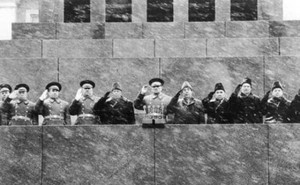
The Czar is dead. Who'll man the Politburo?
The U.S. apparently will have a de-facto Politburo, rather than a single car czar. The Obama administration reportedly is prepared to name a task force led by Treasury Secretary Timothy Geithner and National Economics Council Chairman Larry Summers. The third member of the task force would be Ron Bloom, a former Wall Street Banker, turned labor activist, who over the years has advised the Air Line Pilots Association, United Steel Workers and the United Auto Workers. Bloom also played a pivotal role in the restructuring of the U.S. Steel industry.
Bloom’s appointment, if it comes to pass, means that the panel will have a decidely pro-union tilt, which could make it easier for the UAW to accept some concessions. “We are going to need a restructuring of the these companies,” noted David Axelrod, a top advisor to Pres. Obama, during a Sunday appearance on Meet the Press. However, Axelrod also stressed that UAW members aren’t the only ones to sacrifice.
Chrysler and General Motors are preparing to provide the U.S. Treasury with a preliminary plan, showing how they plan to repay the loans and become profitable. Those plans are due this week. However, key parts of the packages, including revised contracts with the union and negotiations with creditors are still incomplete.
Meanwhile, GM is floating the prospect of declaring bankruptcy to force concessions from reluctant stakeholders, notably its union and bond holders.
Chrysler vice chairman Jim Press stressed that Chrysler has already launched a major restructuring even before it turned to Washington for help. “When we complete our viability plan, we will have cut 32,000 jobs, 1.3 million units of installed capacity and reduced our fixed costs by more than $3.8 billion,” he said.
But Chrysler needs an additional $3 billion in loans, on top of those granted in December, as well as concessions from the United Auto Workers and creditors, Press said. However, with the combination of help from the Treasury Department, concessions from key constituents, and the low interest loans from the U.S. Department of Energy, Chrysler will be able to make it through the current crisis, Press insisted.
Meanwhile, General Motors is using the plan submitted to Congress on Dec.2 to guide its restructuring plans, said GM spokesman Tom Wilkinson. GM also has already slashed more than 1 million units of capacity over the past year and could cut more when it makes its preliminary submission to treasury, said GM.
The company is reducing expenses across the board and has announced plans to 3,400 to eliminate the jobs of an additional 3,400 of its 29,000 salaried employees.
However, GM does not have final approval of the plan from the UAW and bond holders, Wilkinson said.
And that is throwing a monkey wrench into the situation, with weekend reports suggesting that the troubled automaker may switch directions and opt for Chapter 11 bankruptcy. That would make it much easier for GM to get court-ordered concessions from reluctant stakeholders. Whether the company is serious about the bankruptcy option isn’t clear, but the threat certainly adds urgency to ongoing negotiations.
Mark McNabb, general manager of the Cadillac Division, said that GM had already made progress on its restructuring when he joined the company in May, 2008 after more than 20 years. “They had already done a lot,” said McNabb, who was brought in to head the streamlined luxury division that now includes two brands that GM has put up for sale – Hummer and Saab. “But if you look at what happened sales went from a 15 million-unit annual rate in May to less than 10 million units in January. That’s a 50 percent drop,” he said.
UAW President Ron Gettelfinger also has blamed the current crisis on the broader economy and has defended the union contracts with both companies. Gettelfinger also has pointedly noted the union never signed the original terms sheets back in December and suggested deadlines, including this week’s are probably unrealistic. Gettelfinger also has said Republican Senators have demanded concessions from the UAW in an effort to punish the union.
Last month, Gettelfinger said he was not prepared to replace cash to fund the Voluntary Employment Benefit Association set up in 2005 to pay for retiree health care, which had become a point of contention between the automakers and the union. Taking equity could jeopardize the health-care benefits of thousands of retired union members, he said.
The UAW president also has rejected the comparative statistics measuring labor costs from companies such as Oliver Wyman & Associates Inc. of New York, showing Toyota’s U.S. labor costs are $54 per hour, while GM’s are $73 per hour.
The UAW already agreed to eliminate the jobs bank, which kept workers on the company payroll after their jobs had been eliminated. The union also agreed to a new round of employee buyouts at both Chrysler and GM. Some 27,000 Chrysler workers and 62,000 GM workers have been offered the buyouts in advance of the Treasury submission.
The buyouts will help lower both companies labor costs by reducing the number of expensive employees on their payroll or replacing older employees with a lot of seniority with new workers hired for half the wages and fewer benefits.
